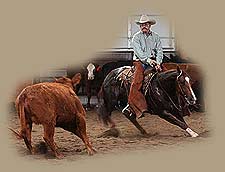
Stock Work

For working with
stock, the horse the cowhands rank first is the Quarter
Horse. It has
"cow savvy"--an instinct for outguessing and outmaneuvering a steer on
the run. Like any other animal, the Quarter
Horse has to be trained for
its work, but it is willing to learn and can develop an uncanny ability.
Its talent may well be inherited from its hot-blooded ancestors, horses that
were used by Mediterranean peoples and by the American Indians not only for
herding but for bull-baiting and buffalo-running as well.
The Quarter
Horse is masterful in every phase of stock
work--roping, bulldogging, and cutting. But it is in cutting--separating
an animal from the herd--that a Quarter
Horse really demonstrates wizardry; this
is often a main attraction in rodeos and Western shows. Once the cow to be
cut from the herd has been indicated, the horse works on his own without
direction from his rider. He has learned to keep the position of advantage
over a cow. As it breaks away, he heads it off with a burst of speed; as
it reverses or feints, he digs in to a dead stop, pivots, and lunges forward to
turn the cow onto another tack. If the cow makes a run, he calculates the
perfect drift for intercepting it. It is an extraordinary display of
equine agility. A good Quarter
Horse also knows his part in calf roping
and performs with nimbleness and know-how.
The training of such a horse is usually completed by the time
he is four or five years old. It may begin when he is as young as three
weeks. One very successful trainer begins with a horse four years of age
and completes its training in one year. So there is no rigid procedure in
the making of a Quarter
Horse cow pony. It all adds up to developing the
animal's inborn knack. Trivia: Vaqueros is
the name given to the Spanish cowboy; they were among the first cowboys in
America. The western cowboy is responsible for taking care of the vast
herds of cattle and horses belonging to the rancher for whom he works.